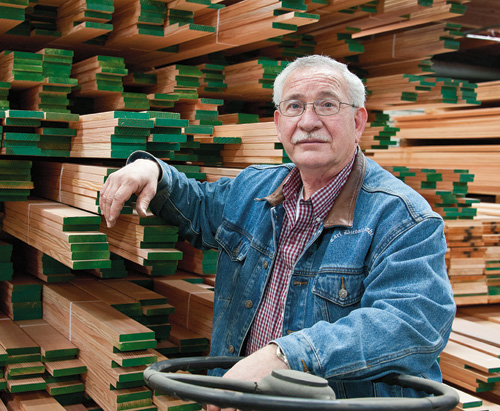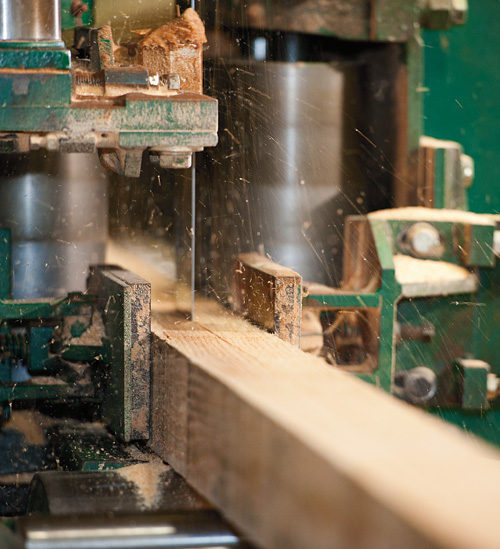 A third-generation president works to ensure Diebold Lumber in Troutdale evolves to survive.
A third-generation president works to ensure Diebold Lumber in Troutdale evolves to survive.
BY DAN MCMILLAN
 |
Third-generation president Jim Patrick is working with his team to ensure the success of Diebold Lumber in Troutdale.// Photo by Adam Bacher |
Diebold Lumber’s president, Jim Patrick, leans forward when Jerry Lawson, his vice president of sales, leaves the room and confides he’d like to see Lawson run the company someday.
The 67-year-old Patrick credits Lawson, 48, with bringing new energy and perspectives to his third-generation lumber company and is willing to trust Lawson and operations manager Dave Smith with his company’s future and its hard-earned reputation.
“We’ve never gone for the cheaper route,” Patrick says. “We’ve always gone with better.” And he expects the future leaders to continue that tradition.
Lawson returns the compliment by praising Patrick for creating a well-respected business that is positioned to survive into a fourth generation.
| Diebold Lumber |
| President: Jim Patrick |
| Incorporated: 1940 |
| Employees: 40 |
| Fun fact: Diebold Lumber can process 40 million board feet of lumber per year, enough to build 4,000 1,800-square-foot-houses. |
But both know innovation is key in a world where it can be cheaper to ship lumber to China for re-manufacturing than doing the work in the U.S., even when the finished product is destined for the U.S. market.
The foundation of Diebold’s reinvention is a lean initiative that provides a way to frame every issue that faces the company: “How do we get more efficiency from the wood we’ve got,” Lawson says.
 |
 |
// Photos by Adam Bacher |
To that end, Lawson and Patrick have every one of the 40-some employees — they would like to double the employee count — attending regular meetings to discuss ways to operate more efficiently. Mill employees evaluate the kiln operations, and vice versa. No item is too small to consider. For example, a recent idea that’s paying dividends called for doing a better job sweeping up nails to cut down time spent repairing fork lift tires, which is a much more cumbersome job than changing a flat on a car, Lawson says.
Diebold is what’s called a custom re-manufacturer. That means Diebold doesn’t own the lumber stacked up around its 17-acre Troutdale facility. The lumber is owned by a mill or third-party vendor who has a contract with an end user for lumber cut to particular dimensions. Diebold does the cutting and also can dry the wood in one of its state-of-the-art kilns, or it can just dry the wood if that’s what the client wants.
“They know what to do once the wood gets here,” says Jim Rodway, president of Portland-based Patrick Lumber and a 25-year Diebold customer. “We don’t want to own a manufacturing facility. We’re good at marketing, and they’re good at manufacturing.
Diebold produces a consistent, quality product that makes Patrick Lumber’s clients happy and allows Patrick Lumber to maintain an edge in a tough business.
Every bit of margin eked out of a job is precious, Lawson says. That’s why Lawson and Patrick are spending time finding a market for left over chunks of four-by-fours. One idea floating around is using the excess lumber to make broom handles and then using that excess for rat-trap components. If Diebold can bring the lumber owner together with a prospective broom-handle buyer, then Diebold and its customer both stand to make a little extra money. If Diebold can then sell the scrap left over from the broom handles to a rat-trap maker, then everyone makes even a little more money. As an added bonus, Diebold gets new customers who appreciate its hard work and innovative thinking.
 |
// Photo by Adam Bacher |
Those broom handles and rat traps may never get made, but that’s beside the point. The point is that 72-year-old Diebold Lumber isn’t just cutting wood and letting the excess fall where it may. It’s remade itself as the kind of lean, efficient manufacturer that knows every small savings and every small increase in margin is critical.
Lawson, a successful lawyer, met Patrick at Patrick’s youngest daughter’s wedding. He was the best man. Lawson later did some information technology work for Diebold, went off to law school and eventually found his way back as vice president of sales.
Patrick says Lawson has brought more of a sales focus to Diebold. “They’ve never had to sell themselves,” Lawson says. “The customers always found them by reputation.” He’s attending trade shows and keeping his ears open for any opportunity.
Another new initiative launched by Lawson and Patrick is a board of advisers made up of veteran business people from within and without the wood products industry. These are all people Lawson has connections with, and they come together regularly to brainstorm ideas and solve problems for Diebold. Patrick calls them “the gray-haired board of advisers.”
Lawson hopes all these efforts are pointing toward a big payoff. He and Patrick are working on a deal that could see a company bring its re-manufacturing work to Diebold instead of China. That would prove there is plenty of room for innovation in Oregon’s oldest industry.

